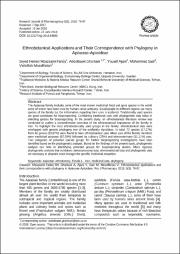Ethnobotanical Applications and Their Correspondence with Phylogeny in Apiaceae-Apioideae
(ندگان)پدیدآور
Moazzami Farida, Seyed HamedGhorbani*, AbdolbasetAjani, YousefSadr, MohammadMozaffarian, Valiollahنوع مدرک
TextReview
زبان مدرک
Englishچکیده
The Apiaceae family includes some of the most known medicinal, food and spice species in the world some of which have been used by humans since antiquity. Local people in different regions use many species of the family but the information regarding their uses is scattered. Traditionally used species are good candidates for bioprospecting. Combining traditional uses with phylogenetic data helps in selecting species for bioprospecting. In the present study, an ethnobotanical literature review was conducted to outline a comprehensive overview of the ethnobotanical importance of the family in Iran. To highlight the most ethnobotanically used groups in the family, ethnobotanical data were overlapped with generic phylogeny tree of the subfamily Apioideae. In total, 72 species (17.27%) from 42 genera (33.87%) were found to have ethnobotanical uses. Main uses of the family members were medicinal purposes (67.30%) followed by culinary (25%) and ethnoveterinary (11.11%) uses. Two categories of potential species groups for further bioprospecting investigations have been identified based on the phylogenetic analysis. Based on the findings of the present study, phylogenetic analysis can help in identifying potential groups for bioprospecting studies. More rigorous phylogenetic analysis that combines chemotaxonomy data, ethnomedicinal data and phylogenetic data are necessary to pinpoint exact lineages for specific medicinal properties.
کلید واژگان
Apiaceaeethnobotany
Ferula L
Iran
medicinal uses
Phylogeny
Ethnobothany
Phylogeny
شماره نشریه
3تاریخ نشر
2018-07-011397-04-10
ناشر
- The Iranian Society of Pharmacognosy - Shahid Beheshti University of Medical Sciencesسازمان پدید آورنده
Department of Biology, Faculty of Science, Bu-Ali Sina University, Hamadan, Iran.Department of Organismal Biology, Evolutionary Biology Centre, Uppsala University, Sweden. Traditional Medicine & Materia Medica Research Center, Shahid Beheshti University of Medical Sciences, Tehran, Iran.
Plant Bank, Iranian Biological Resource Center (IBRC), Karaj, Iran.
History of Science, Encyclopedia Islamica Research Center, Tehran, Iran.
Research Institute of Forests and Rangelands, Tehran, Iran.
شاپا
2345-44582345-5977





